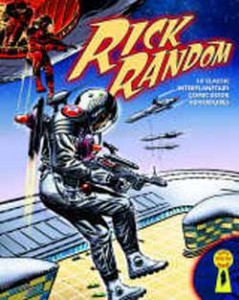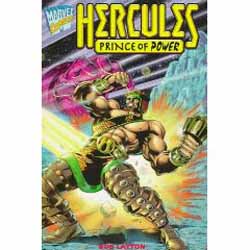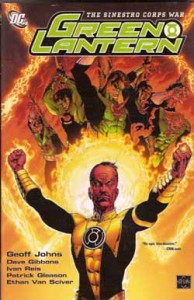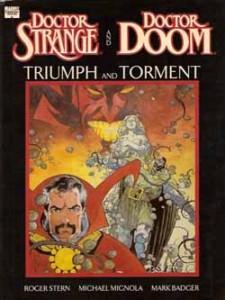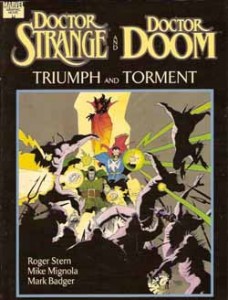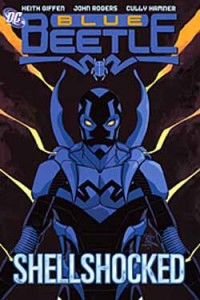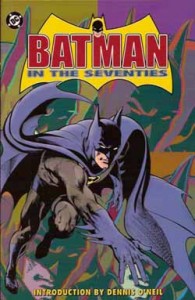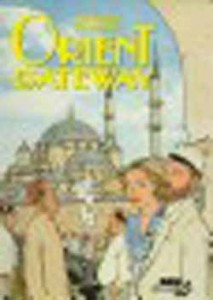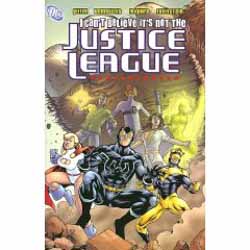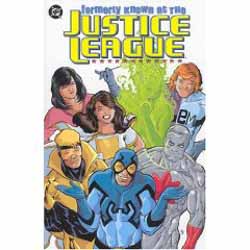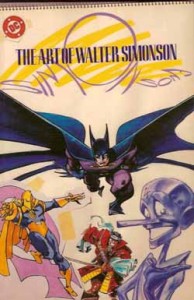
By Walter Simonson & various (DC Comics)
ISBN: 0-930289-41-2
Here’s an endeavour DC should have pursued when they first thought of it. In 1989, at the dawn of commercial trade paperback publishing, instead of collecting key or beloved storylines into spiffy book editions, someone had the bright idea of collecting the less well known works of a particular fan-favourite artist: in this case Walt “my signature is a dinosaur†(and you’ve got to be a fan-boy of a certain age to remember that one) Simonson.
A brilliant imagination and, by his own admission, more designer than artist, Simonson broke through in the standard manner in the early 1970s by illustrating a few short stories for DC’s large complement of anthology comics – a valuable and much-missed proving ground for budding talent. Whilst working on Fritz Leiber’s licensed property Fafhrd and the Gray Mouser for the seminal Sword of Sorcery comic-book he was commissioned by Archie Goodwin to illustrate the groundbreaking, award-winning Manhunter feature for Detective Comics (#437-443), and was instantly catapulted to the forefront of comics creators.
This 208 page volume features some fine examples of his long and illustrious career, highlighting a great deal of superb material that newer fans might be unaware of, and indeed many older lags too. After the lovely introduction from comrade and compatriot Howard Chaykin the wonderment begins with ‘The Cape & Cowl Deathtrap’ from Detective Comics #450 (1975), a stylish Batman thriller scripted by Elliot Maggin, followed by the best Dr. Fate story of the decade from First Issue Special #9 (1975). This untitled delight, written by Martin Pasko, and featuring a diabolical Egyptian mummy, allowed the artist to stretch himself and explore his increasing fascination with patterns, symbols and especially typography. It’s a cracking good read too.
Marvel Comics have been producing creator-specific compilations for the last couple of years and I’ve been less than kind about many of them. My biggest beef is not just empty griping though as this book proved nearly twenty years ago.
Captain Fear was a pirate strip that had run in Adventure Comics, illustrated by the unique Alex Nino. Simonson and writer David Michelinie (with lettering whiz John Workman) revived the feature for a superb three-issue run in the back of Unknown Soldier (#254-256, 1981), and all three chapters are presented here, rather than just an unsatisfactory, incomplete fragment. At least some editors remember that readers like to know how stories begin and end…
‘U.F.M’, scripted by Gerry Boudreau, was Simonson’s second professional sale to DC and appeared in the Goodwin edited Star-Spangled War Stories #170 (1973). It’s a straight but stylish “Future Shock†type of science fiction tale but was popular enough to warrant a sequel the following year. ‘The Return’ by the same team (Star-Spangled War Stories #180) might also charm the celebrity conscious comics fan since the likes of Howard Chaykin, Daina Grazunias and Gray Morrow modeled for the humans in this little treat.
Hercules Unbound was a post-apocalyptic fantasy title created by Gerry Conway when he first joined DC in 1976. It was bizarre, eclectic and a little hit-or-miss, but it had art by a veritable who’s who of top artists including Jose Luis Garcia-Lopez and Wally Wood. By the time Cary Bates and Simonson took over the title it was already slated for cancellation, bur DC deferred the chop until the creators could bring the saga to a proper conclusion. From the last two issues in 1977, (#11 and 12 if you’re counting) comes ‘Dark Side of the Gods’ and ‘Chaos Among the Gods’ a bravura cosmic romp and a clear indication to me that a complete volume should be a matter of priority for DC’s powers-that-be.
The book concludes with a true epic, both in content but also in length. Beginning with a one-shot scripted by Steve Gerber, and published as Metal Men #45 it turned into a full revival of the robotic heroes, with Conway and Pasko continuing the writing and Simonson having great fun producing five full issues of metallic mayhem, both funny and thrilling. And again, the whole lot is included here. ‘Evil is in the Eye of the Beholder’, ‘The Chemo Conspiracy’, ‘The X Effect’, ‘Who is Bruce Gordon’ and ‘The Dark God Cometh’ (Metal Men #45-49 inclusive, 1976-1977) form a wonderful, old fashioned comics experience, packed with humour, dazzling to look at, and it even features a classic guest-villain in the nefarious Eclipso.
With each tale supported by informative commentaries from Simonson and topped off by a superb 10 page portfolio of sketches and cover reproductions at the back, this is a deeply satisfying treat for eyes and brains everywhere, long overdue for re-release and a valuable example of a type of book that DC’s back catalogue is perfect for.
How many comics legends can you think of that could easily and satisfactorily fill a book like this? Kirby, Wrightson, Wood, Redondo, Garcia-Lopez, Toth, Aragones… the list really is endless.
© 1989 DC Comics. All Rights Reserved.

